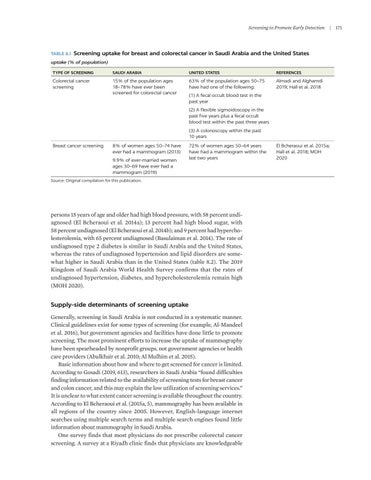Screening to Promote Early Detection | 171
TABLE 8.1 Screening
uptake for breast and colorectal cancer in Saudi Arabia and the United States
uptake (% of population) TYPE OF SCREENING
SAUDI ARABIA
UNITED STATES
REFERENCES
Colorectal cancer screening
15% of the population ages 18–78% have ever been screened for colorectal cancer
63% of the population ages 50–75 have had one of the following:
Almadi and Alghamdi 2019; Hall et al. 2018
(1) A fecal occult blood test in the past year (2) A flexible sigmoidoscopy in the past five years plus a fecal occult blood test within the past three years (3) A colonoscopy within the past 10 years
Breast cancer screening
8% of women ages 50–74 have ever had a mammogram (2013) 9.9% of ever-married women ages 30–69 have ever had a mammogram (2019)
72% of women ages 50–64 years have had a mammogram within the last two years
Source: Original compilation for this publication.
persons 15 years of age and older had high blood pressure, with 58 percent undiagnosed (El Bcheraoui et al. 2014a); 13 percent had high blood sugar, with 58 percent undiagnosed (El Bcheraoui et al. 2014b); and 9 percent had hypercholesterolemia, with 65 percent undiagnosed (Basulaiman et al. 2014). The rate of undiagnosed type 2 diabetes is similar in Saudi Arabia and the United States, whereas the rates of undiagnosed hypertension and lipid disorders are somewhat higher in Saudi Arabia than in the United States (table 8.2). The 2019 Kingdom of Saudi Arabia World Health Survey confirms that the rates of undiagnosed hypertension, diabetes, and hypercholesterolemia remain high (MOH 2020).
Supply-side determinants of screening uptake Generally, screening in Saudi Arabia is not conducted in a systematic manner. Clinical guidelines exist for some types of screening (for example, Al-Mandeel et al. 2016), but government agencies and facilities have done little to promote screening. The most prominent efforts to increase the uptake of mammography have been spearheaded by nonprofit groups, not government agencies or health care providers (Abulkhair et al. 2010; Al Mulhim et al. 2015). Basic information about how and where to get screened for cancer is limited. According to Gosadi (2019, 613), researchers in Saudi Arabia “found difficulties finding information related to the availability of screening tests for breast cancer and colon cancer, and this may explain the low utilization of screening services.” It is unclear to what extent cancer screening is available throughout the country. According to El Bcheraoui et al. (2015a, 5), mammography has been available in all regions of the country since 2005. However, English-language internet searches using multiple search terms and multiple search engines found little information about mammography in Saudi Arabia. One survey finds that most physicians do not prescribe colorectal cancer screening. A survey at a Riyadh clinic finds that physicians are knowledgeable
El Bcheraoui et al. 2015a; Hall et al. 2018; MOH 2020

